Music
Trailers
DailyVideos
India
Pakistan
Afghanistan
Bangladesh
Srilanka
Nepal
Thailand
StockMarket
Business
Technology
Startup
Trending Videos
Coupons
Football
Search
Download App in Playstore
Download App
Best Collections
Technology
Itno secret that adaptability has become a critical trait for knowledge workers. To stay on top of a rapidly evolving world, we must assess new situations, make intelligent decisions and implement them effectively.
A 2014 research report by Barclays indicated that 60% of employers say adaptability has become more important during the last decade, and BBC called adaptability the &X factor& for career success in an era of technological change.
But even the most intrepid executive, entrepreneur or freelancer would be forgiven for struggling to adapt to a global pandemic. The impact of coronavirus has been unrelenting: hospitals at capacity, students sent home, conference cancellations, sold out inventory, markets in free fall and cities under lockdown.
Whatever you thought 2020 was going to look like, you were dead wrong. Box CEO Aaron Levie and Stanford professor Bob Sutton recent Twitter exchange said it all:
This moment requires us to learn new skills, develop new habits and let go of old ways of working. In the book &Range,& therea chapter about &dropping familiar tools& that details how experienced professionals will overlearn specific behavior and then fail to adapt to a new circumstance. This mentality affected everyone from firefighters to aviation crews to NASA engineers, often with deadly results, and underscores how hard it can be to adapt to change.
To help us cultivate adaptability in this unprecedented moment, I sought answers in unexpected places. Herewhat I learned.
Let go of your attachments
Adaptability is required first and foremost when circumstances change. Iteasy to get attached to certain outcomes, especially when they&ve been planned long in advance or have significant emotional weight.
Due to coronavirus, a couple I know is postponing their wedding originally set for April. Having tied the knot only a year ago myself, I can&t imagine how frustrating that must be for them. But it was the right decision; demanding that the show go on would have been dangerous for their families, friends and the public at large.
I recently spoke with my friend Belinda Ju, an executive coach with a longstanding meditation practice. Non-attachment is a core concept of Buddhism, the spiritual path shefollowed for many years, and I wanted her thoughts on how that idea might help us adapt to unforeseen circumstances.
&Attachment doesn&t work because certainty doesn&t work. You can&t predict the future,& she explained. Being attached to something means &seeing the world through a false lens. Nothing is fixed.& For Ju and her clients, non-attachment doesn&t mean giving up on goals — it means focusing on what you can control.
&You might have a fixed goal of needing to raise X million dollars to keep your team afloat,& she said. &But in the age of coronavirus, investors might be slower to respond. So what are the levers in your control? What are the options you have and the pros and cons to each one?&
Her points hit home for me. As a NYC-based startup founder, I was preparing to make several trips to the West Coast to raise the next round for my company, Midgame, a digital party host for gamers.
I like pitching in person, but thatobviously not going to happen, so I need to embrace video calls as my new reality. By doing that, I can get to stocking up on coffee, cleaning up my work space and setting up a microphone so when I do pitch over video, I&m bringing my A game.
Be present
Another way to think about adaptability is that itthe ability to improvise. In theater, improv performers can&t rely on prewritten lines, and have to react in real time to suggestions from the audience or the words and actions of their scene partners.
& ‘Playing the scene you&re in& is a principle from improv which means to be present to the situation you&re in.&
Thatwhat Mary Lemmer told me. As an entrepreneur and VC who spent a stint at The Second City improv theater in Chicago, Lemmer knows a thing or two about having to adapt. Today, she brings her insights to corporations through training and workshops.
She explained that as an improv performer, you may start a scene with a certain idea in mind of how it will go, but that can quickly change. &If you&re not present,& she said, &then you&re not actively listening and because thereno script, you&ll miss details. Thatwhen scenes fall apart.&
When I was a PM at Etsy and we had a major launch, we&d get engineering, dev ops, product, marketing and customer support together in a room to talk through the final event sequencing. These weren&t always the most exciting meetings and it was easy to get distracted by email or chat. One time engineering announced a significant last-minute issue that almost slipped through the cracks. Luckily, someone piped up with a clarifying question and we were all able to work together to minimize the issue.
Lemmer argues that in improv, like in business, you can&t make assumptions about people or situations. &We see this a lot in board meetings. People start to assume ‘Sally& will always be the proactive one or ‘Jim& will always be the naysayer and tune out.&
This is kind of attitude is problematic in a stable environment, but downright dangerous in an unstable situation where new data and events can quickly open up a new set of challenges and opportunities.
Early on, some experts thought the coronavirus crisis would stabilize globally by April. In early February, S-P Global stated that in the &worst-case scenario,& the virus would be contained by late May. A month later, that prediction already looked wildly optimistic.
Build mental toughness
Experts are saying now that cases may peak in May or June, which means everyone should be hunkering down for eight or more weeks of social distancing and isolation. A COVID-19 vaccine just started human trials, but testing in large enough sample sizes to identify side effects and then ramping up large-scale production still might not be fully available for more than a year.
In other words, dealing with this virus is not a sprint, ita marathon. A marathon no one signed up for.
Someone who knows a lot about this topic is Jason Fitzgerald. A 2:39 marathoner, Fitzgerald now helps people run faster and healthier as an author and coach.
When we spoke over the phone, he pointed out that running, unlike say basketball or gymnastics, is a sport where &you have to voluntarily want to experience more and more discomfort.&
Fitzgerald calls this ability to endure &mental toughness,& and ita skill we all can build. For runners, it requires doing workouts that scare them, putting in mileage thathigher than they have in the past and racing regularly. Italso about accepting and even embracing the pain of running hard.
The same is true for adaptation. We can train ourselves to respond better to change (we&re all getting lots of practice right now!), but developing new habits and working in new ways is always uncomfortable. As decorated cyclist Greg LeMond once said, &it doesn&t get easier, you just get faster.&
We also have to recognize that we won&t get it right every time. &The more that we get comfortable with poor performances, the more we can learn from them,& Fitzgerald said, noting that hehad his share of bad races, including failing to finish an ultramarathon in 2015. &Sometimes you dwell on a bad race for a couple days, but then you have to just forget about it and move on with your training.&
Many of us are reeling from more cancellations, suspensions and complete one-eighties in the last month than in the last five years. But we can&t let ourselves stay bogged down by our feelings of frustration or disappointment. We accept our new reality, learn what we can from it, and keep going.
Itclear that the people who can let go of their past plans and embrace the new environment ahead will thrive. Already we&re seeing companies pivot from live events to online webinars, and remote-first workplaces becoming the new normal. Shares of Zoom have risen even as the stock market has taken a beating and I&m sure other winners will emerge in the coming weeks and months.
But adaptability doesn&t just matter for individuals or even companies, it matters for governments. For China, Taiwan and Hong Kong, thanks to aggressive testing and quarantining efforts, life is returning, somewhat, to normal. New cases are on the decline and therehope of life returning to normalcy in the near future. Countries that bungled their response to the disease progression, including Italy, Spain, the U.K. and the United States, are now facing increasingly dire consequences.
Whether you want to survive a global pandemic, reach the next phase in your career or be selected on a mission to Mars, ithard to overstate the importance of adaptability in getting there.
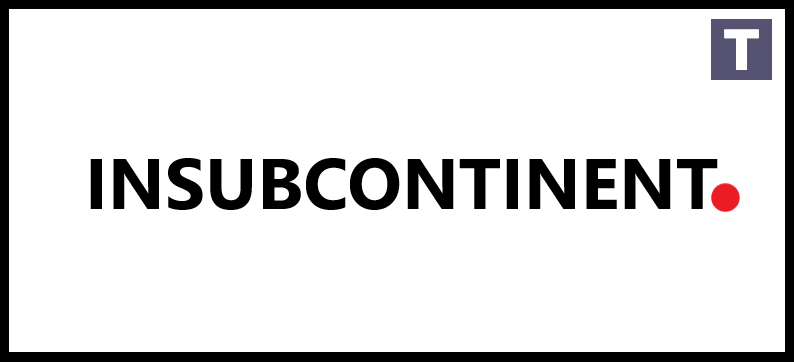
- Details
- Category: Technology Today
Read more: Cultivating adaptability is a pandemic coping skill
Write comment (98 Comments)The massive surge of COVID-19-related layoffs has put tech in a unique position. While the startup world is facing layoffs itself, it is also trying to help get people back to work.
Back at the end of 2019, the SoftBank-backed belt-tightening period led to a flurry of crowdsourced spreadsheets with employee names from companies like Oyo, WeWork, Zume and more. The spreadsheets popped up as a bet on the network effect, with the ultimate goal of hoping the sheets land in the hands of a recruiter looking to hire one of hundreds laid off. Now, as COVID-19 cripples the economy, layoffs have surged dramatically past that one period.
On one end, we&ve reported on numbers of tech companies cutting staff, from Oyo, toZipRecruiter, to TripActions. But on the other, brighter end, we&ve also seen the rise of platforms to connect those laid off and pledges from employers to not fire any employees during this trying time.
In a world where people are laid off on Zoom, techefforts to give community, and a course of action, to those laid off is undeniably important.
The current climate of the pandemic, and the massive unemployment that has resulted, means that a spreadsheet with a long list of employee names and unverified contact information doesn&t cut it.
Shannon Anderson, the director of talent at Madrona Venture Group in Seattle, saw her firmportfolio companies struggling with layoffs and the changing economy. Two of the portfolio companies, Textio and Rover, laid off staff, along with a number of other companies.
&We wanted to anticipate a reduction in force across the ecosystem,& said Anderson. &Ita global problem.&
So, to help boost the network of those laid off, Anderson reached out to a number of HR leaders, including Chris Brownridge, the founder of Silver Lining, a job platform for those who have been laid off. He started Silver Lining after he shut down his startup last summer and had to lay off his staff of 20.
&I felt the pain [of layoffs] from the employer side, and it is painful for the employer, especially when you care about [your workers],& he said back in January. &I don&t want to keep seeing spreadsheets thrown around; I think that is not the right answer. We need a standardized way to deal with it, with a community behind it.&
Silver Lining is a platform that lets candidates submit profiles for recruiters from top companies to review. Job seekers on the site range from architects, UX designers, engineers, community managers and more.
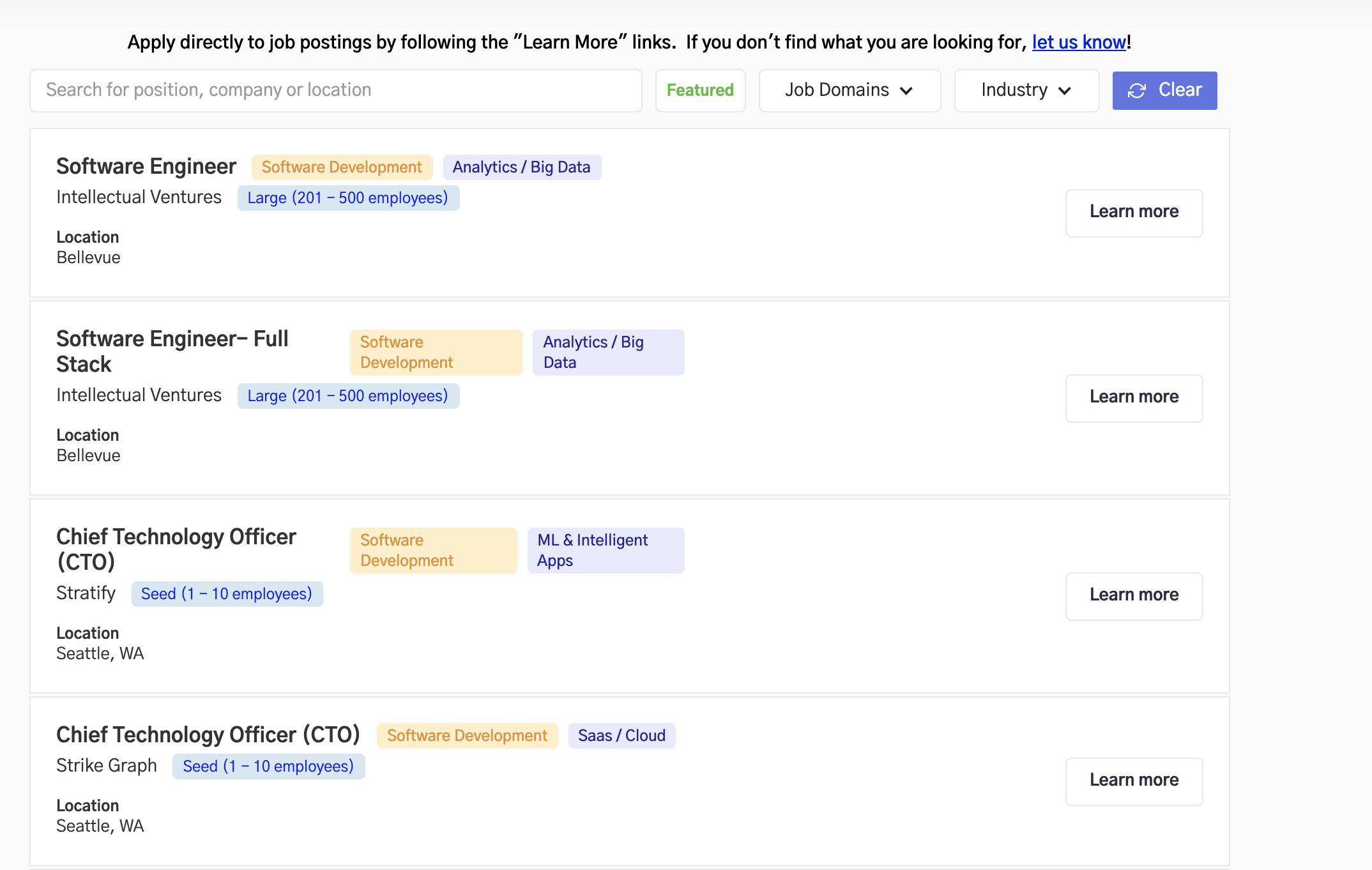
Then COVID-19 spread across the world, forcing people to stay home and spend less. The economydownturn unevenly impacted companies around the world: where layoffs exist for the travel sector, usage surges exist for the remote work companies. But as a whole, the labor force is struggling, with 6.6 million Americans filing for unemployment just last week alone.
Madrona said it is donating a portion of its budget to help Silver Lining offer more services to those laid off. The firm declined to share the total amount of the donation.
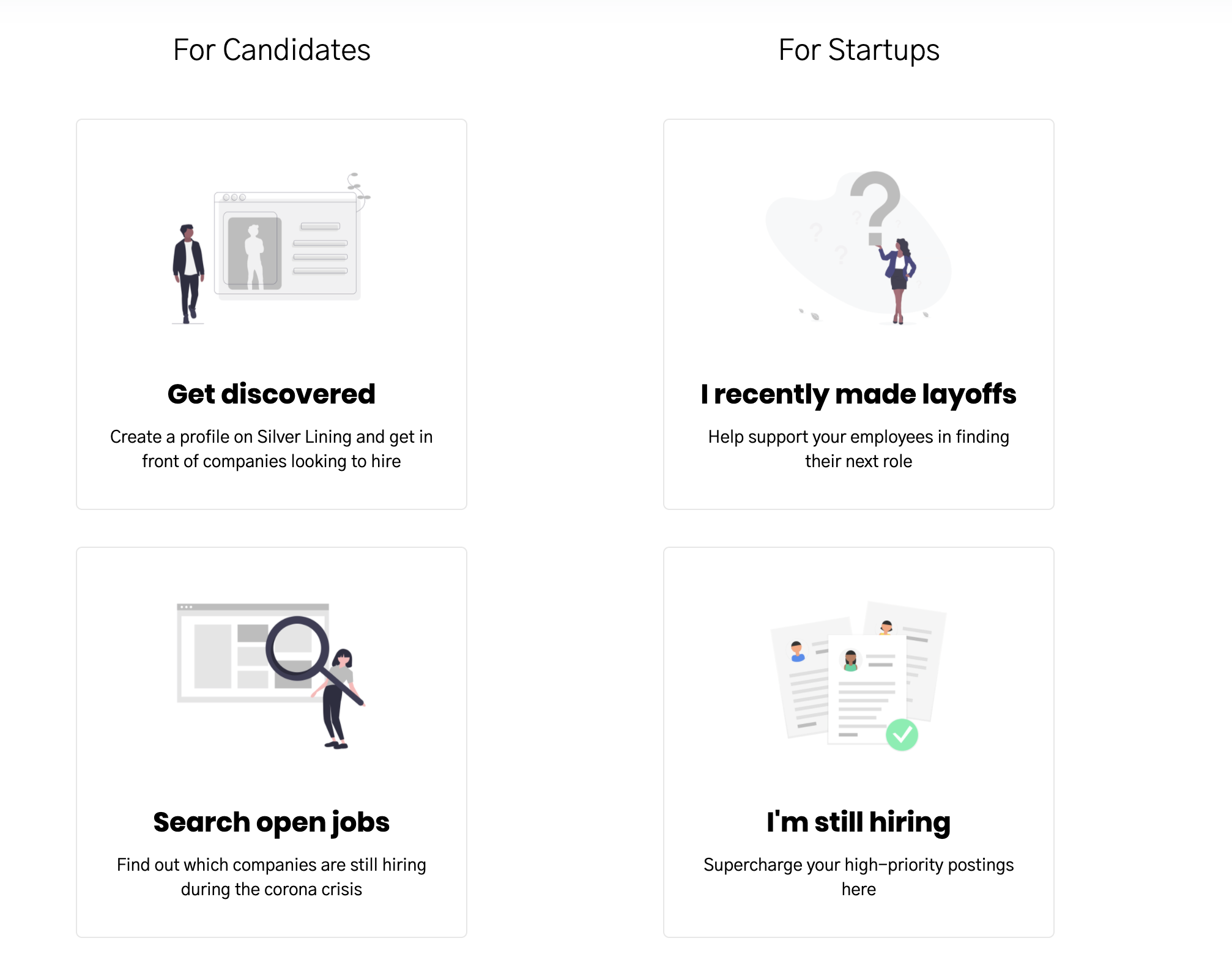
Silver Lining will also now offer coaching, resume writing and emotional support to folks on the platform, Brownridge says. Thanks to donations from Madrona, Skytap, Bandwidth, Voodle, Female Founders Alliance and more, the site is free to use.
The uptick in layoffs has led Boston-based Drafted, a referral startup, to launch a product called the Layoff Network to help those who have been laid off. The startup previously was sending out a newsletter, Layoff List, of weekly list of layoffs with spreadsheets hyperlinked. During the SoftBank layoffs, Olivia Clark, the creator of the newsletter, noticed a surge in traffic — more than 1,000 recruiters subscribed.
Now she says traffic is &up 2,000%& and, in just two weeks, Draftedengineering team has productized that newsletter into a job search network.
The Layoff Network connects with recruiters people who have been recommended by their colleagues and &endorsed& for their skills. If you&re laid off, you can sign up and create a profile and ask a previous employer or colleague to recommend you. Clark says this is similar to LinkedIn&endorse& feature to make sure the people are credible.
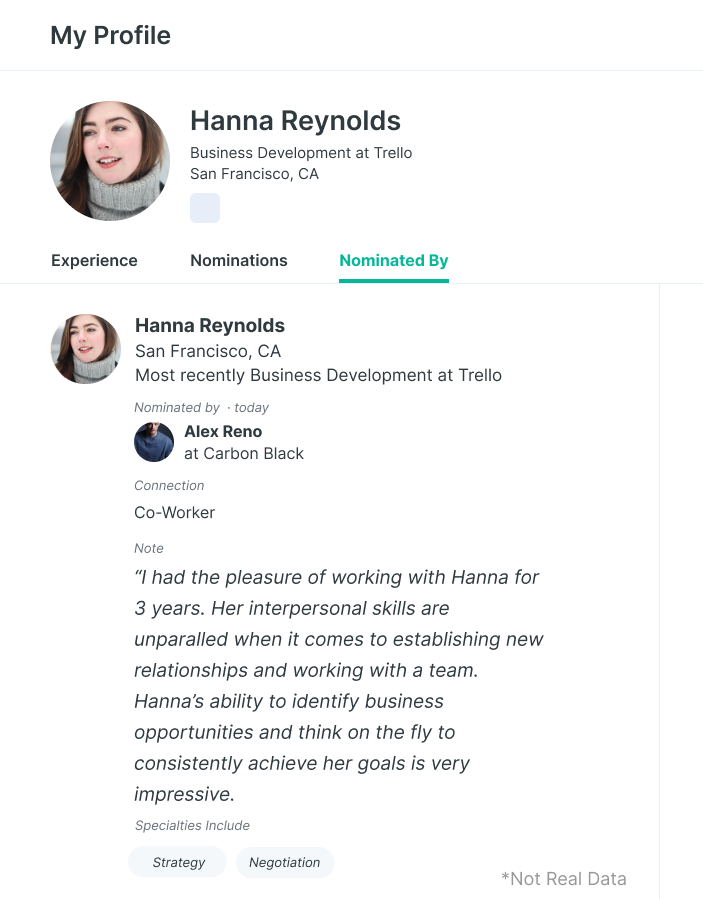
Once the person has been endorsed, they will be added to a talent feed. That is where recruiters can search for nominees, job titles, companies or locations. Unlike a spreadsheet, this is clearly easier to navigate and adds another layer of human touch.
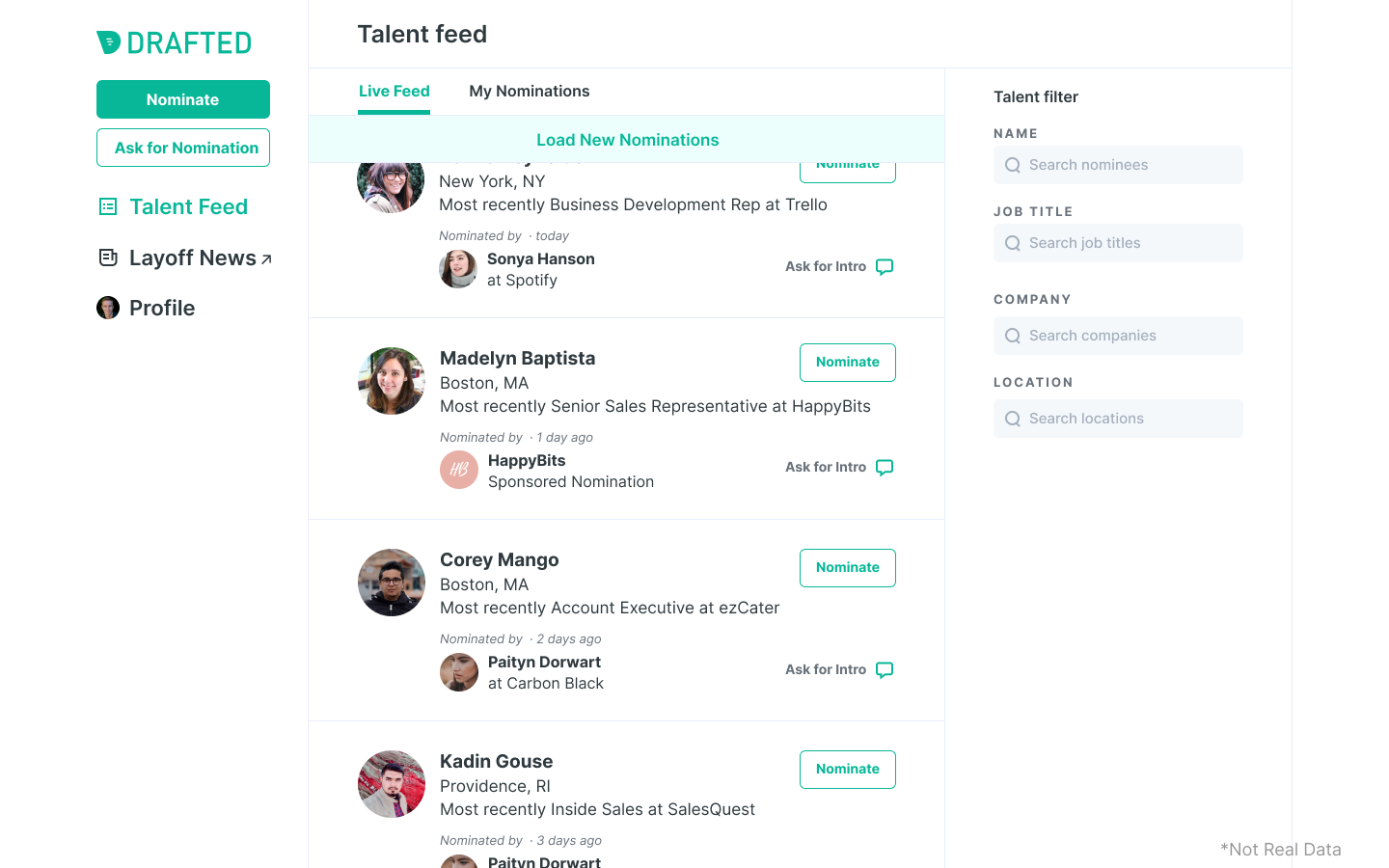
Clark says that the platform will be free for individuals who have been laid off, and who are recruiting or hiring. Drafted has a paid enterprise level that is for organizations that are conducting mass layoffs and want to provide support for former employees.
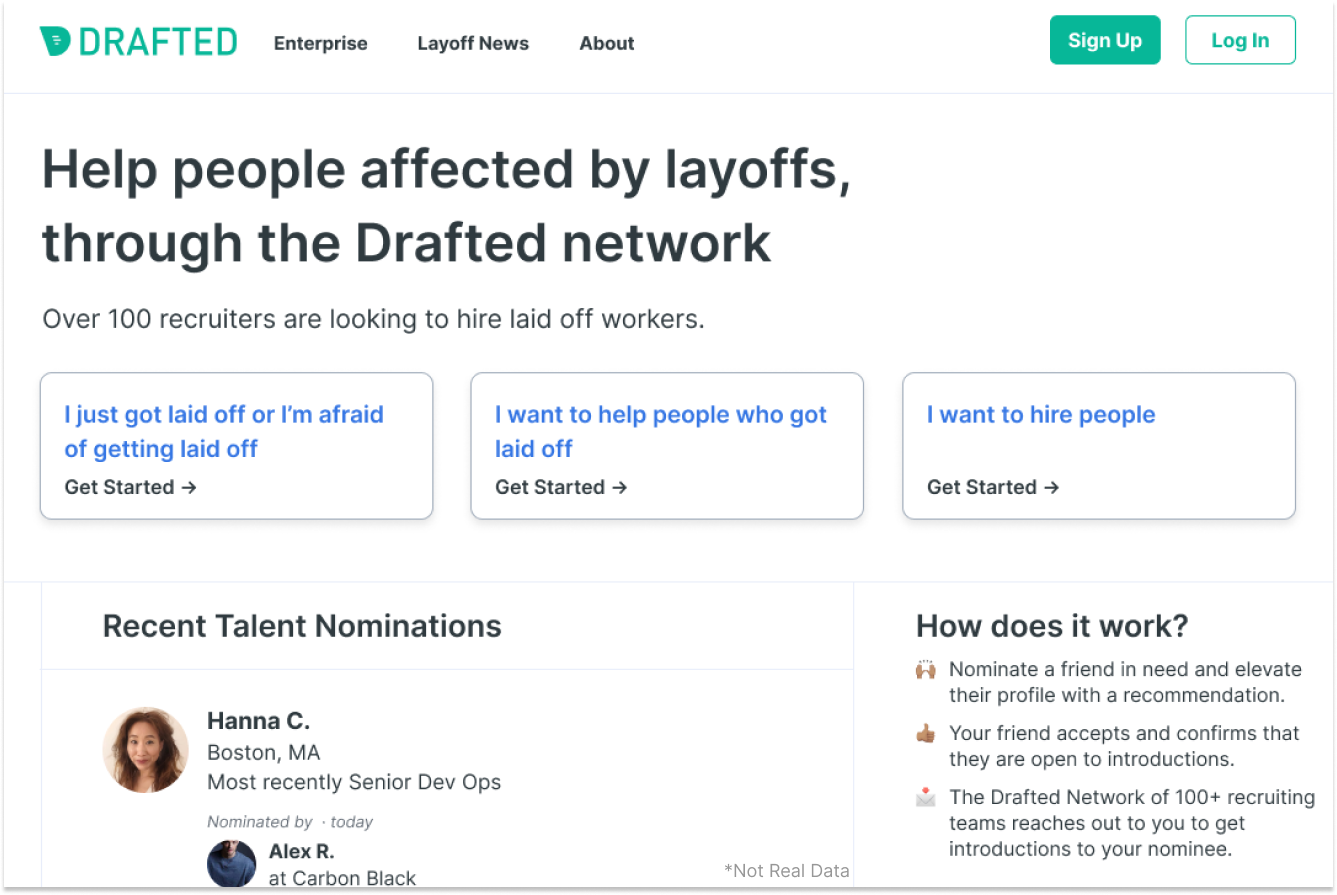
The grassroots efforts are vast and diverse. Herea list that posts companies that are actively hiring. Herea list for Canadian tech workers, and one for Coloradotech scene. And herea live tracker of startups that have issued layoffs, started by the team over at Human Interest, a startup that has nothing to do with layoffs.
Megan Murphy, who created Chicago Superstars for those laid off from the Chicago tech scene, has not received donations or support yet. As the number of unemployed people increases, Murphy says shenoticing a lack of clarity on which companies are hiring, and which job postings are still active. If a company was hiring for a position in January, it might not be anymore (to help keep costs down).
&I can&t waste time crafting cover letters and custom resumes for jobs that won&t actually move forward,& she said. &There are tons of crowdsourced tools trying to flag whoactually hiring still, while others are trying to flag whoinstituted a hiring freeze or laid people off, and in the meantime, company career pages aren&t up to date. We need one source of truth — and right now nobodyreally set up to do that.&
For now, Murphy says shegetting creative in her own search, and asking for others to do the same. &Virtual communities and experiences are about to be more important than ever.& She notes guerrilla Slack channels and Reddit as an example of organic communication.
As for how sheable to keep up with the demand of people needing help for their next job? Murphy, who is looking for a job herself after getting laid off, says she has fewer interviews from potential employers, so shebeen able to help those reaching out.
The work done by these entrepreneurs scratches at the same hope that lies within the hundreds of lines of contact information within a crowdsourced layoff spreadsheet: a need for a community in a trying time. And these days, more than most, remind us of the power of having a group of people together in the first place.
- Details
- Category: Technology Today
Read more: As tech layoffs surge, some support emerges for those without a job
Write comment (98 Comments)Hours after security researchers at Citizen Lab reported that some Zoom calls were routed through China, the video conferencing platform has offered an apology and a partial explanation.
To recap, Zoom has faced a barrage of headlines this week over its security policies and privacy practices, as hundreds of millions forced to work from home during the coronavirus pandemic still need to communicate with each other.
The latest findings landed earlier today when Citizen Lab researchers said that some calls made in North America were routed through China — as were the encryption keys used to secure those calls. But as was noted this week, Zoom isn&t end-to-end encrypted at all, despite the companyearlier claims, meaning that Zoom controls the encryption keys and can therefore access the contents of its customers& calls. Zoom said in an earlier blog post that it has &implemented robust and validated internal controls to prevent unauthorized access to any content that users share during meetings.& The same can&t be said for Chinese authorities, however, which could demand Zoom turn over any encryption keys on its servers in China to facilitate decryption of the contents of encrypted calls.
Zoom now says that during its efforts to ramp up its server capacity to accommodate the massive influx of users over the past few weeks, it &mistakenly& allowed two of its Chinese data centers to accept calls as a backup in the event of network congestion.
From ZoomCEO Eric Yuan:
During normal operations, Zoom clients attempt to connect to a series of primary datacenters in or near a userregion, and if those multiple connection attempts fail due to network congestion or other issues, clients will reach out to two secondary datacenters off of a list of several secondary datacenters as a potential backup bridge to the Zoom platform. In all instances, Zoom clients are provided with a list of datacenters appropriate to their region. This system is critical to Zoomtrademark reliability, particularly during times of massive internet stress.&
In other words, North American calls are supposed to stay in North America, just as European calls are supposed to stay in Europe. This is what Zoom calls its data center &geofencing.& But when traffic spikes, the network shifts traffic to the nearest data center with the most available capacity.
China, however, is supposed to be an exception, largely due to privacy concerns among Western companies. But Chinaown laws and regulations mandate that companies operating on the mainland must keep citizens& data within its borders.
Zoom said in February that &rapidly added capacity& to its Chinese regions to handle demand was also put on an international whitelist of backup data centers, which meant non-Chinese users were in some cases connected to Chinese servers when data centers in other regions were unavailable.
Zoom said this happened in &extremely limited circumstances.& When reached, a Zoom spokesperson did not quantify the number of users affected.
Zoom said that it has now reversed that incorrect whitelisting. The company also said users on the companydedicated government plan were not affected by the accidental rerouting.
But some questions remain. The blog post only briefly addresses its encryption design. Citizen Lab criticized the company for &rolling its own& encryption — otherwise known as building its own encryption scheme. Experts have long rejected efforts by companies to build their own encryption, because it doesn&t undergo the same scrutiny and peer review as the decades-old encryption standards we all use today.
Zoom said in its defense that it can &do better& on its encryption scheme, which it says covers a &large range of use cases.& Zoom also said it was consulting with outside experts, but when asked, a spokesperson declined to name any.
Bill Marczak, one of the Citizen Lab researchers that authored todayreport, told TechCrunch he was &cautiously optimistic& about Zoomresponse.
&The bigger issue here is that Zoom has apparently written their own scheme for encrypting and securing calls,& he said, and that &there are Zoom servers in Beijing that have access to the meeting encryption keys.&
&If you&re a well-resourced entity, obtaining a copy of the internet traffic containing some particularly high-value encrypted Zoom call is perhaps not that hard,& said Marcak.
&The huge shift to platforms like Zoom during the COVID-19 pandemic makes platforms like Zoom attractive targets for many different types of intelligence agencies, not just China,& he said. &Fortunately, the company has (so far) hit all the right notes in responding to this new wave of scrutiny from security researchers, and have committed themselves to make improvements in their app.&
Zoomblog post gets points for transparency. But the company is still facing pressure from New Yorkattorney general and from two class-action lawsuits. Just today, several lawmakers demanded to know what itdoing to protect users& privacy.
Will Zoommea culpas be enough?

- Details
- Category: Technology Today
Read more: Zoom admits some calls were routed through China by mistake
Write comment (92 Comments)People seem to love the concept of the battle pass.
Largely popularized by Fortnite, battle passes reward players for playing well, and playing often. The better you do, the more XP you earn; the more XP you earn, the more stuff (new looks for your character, or victory dances to fire off at the end of a gunfight) you unlock. Willing to cough up a few bucks for an optional &premium& battle pass? That&ll open up a whole new set of rewards. The model has made its way into countless games over the last couple of years, from PUBG to Rocket League.
Zelos, an LA-based company out of Y CombinatorWinter 2020 batch, is aiming to make that same concept work across multiple games. Tackle challenges in one game, earn rewards for another — or use your points to buy new games altogether.
Each day, Zelos offers up a handful of challenges across each of the games it supports, like dealing 10,000 damage in League of Legends or getting five kills with Wraith in Apex. Completing a challenge earns you &zips&; most challenges I&ve seen will earn the player somewhere between 15 and 150 zips, depending on how tough it is to pull off.
Once you&ve pooled up a pile of zips, they can be redeemed for all sorts of virtual goodies. The more something would cost otherwise, the more zips it&ll require. For example, 60,000 zips gets you a $5 Steam gift card — or 90,000 zips for $10 worth of Apex Coins. Once you get into the 50,000-200,000 zip range, you can redeem them for digital download codes for games like Rainbow Six Siege, Monster Hunter: World and Tabletop Simulator. Getting the good stuff can mean completing a lot of challenges, but remember: these are games people are playing anyway.
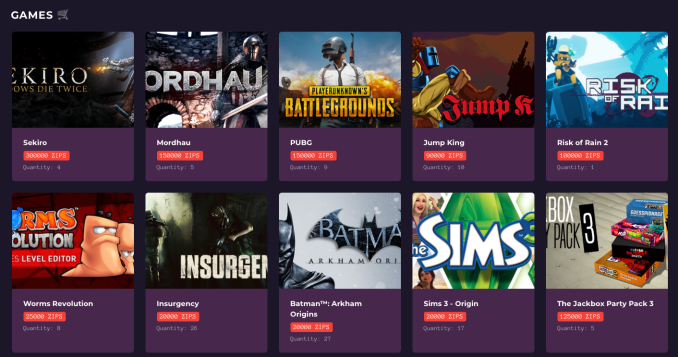
In addition to zips, each challenge earns the player a bit of EXP. EXP levels up your Zelos profile; with each level, you unlock a bundle of zips, additional challenges and items for your Zelos avatar.
Zelos is currently issuing challenges and tracking stats across seven games: Fortnite, Apex, League of Legends, Teamfight Tactics, DOTA 2, Counter Strike: GO and Clash Royale. Stat tracking works a bit better in some games than it does in others, depending on how open a gamedevelopers are with the data. With League of Legends, for example, they&re able to ping Riot Games& dedicated API for a rich backlog of match data; with Apex, on the other hand, they&re limited to pulling stats based on a handful of unlockable trackers players can flip on between matches.
Zelos co-founder Jeffrey Tong tells me they&re focused on ensuring they stay above board with the data they pull, making sure they comply with each providerToS. That makes sense, of course: Getting on a developerbad side could mean losing access to the data firehouse, in turn squashing Zelos& ability to support a game. The more popular games Zelos can support, the better the whole idea works.
So if they&re giving stuff away based on challenges in games they themselves aren&t selling… how will they make money? The same way the aforementioned games do: a premium battle pass. Tong tells me that they&re currently testing a subscription-based battle pass that&ll unlock new challenges, award more prizes and increase the rate at which points are earned.
This isn&t Tongfirst foray into the gaming space; he previously built and sold OverStats, an analytics system for tracking a playeresports stats over time. Co-founder Derek Chiang, meanwhile, was previously a senior software engineer at the decentralized computing company Dfinity.
Tong tells me they raised $2.8 million in the days after YC demo day, eyeing expansion of the platform, supported games and their team. The Zelos team is currently three people, with plans to hire another &six or seven& in the coming weeks. They&re currently seeing more than 50,000 weekly active users, with 55% of their users playing two or more games on the platform.
- Details
- Category: Technology Today
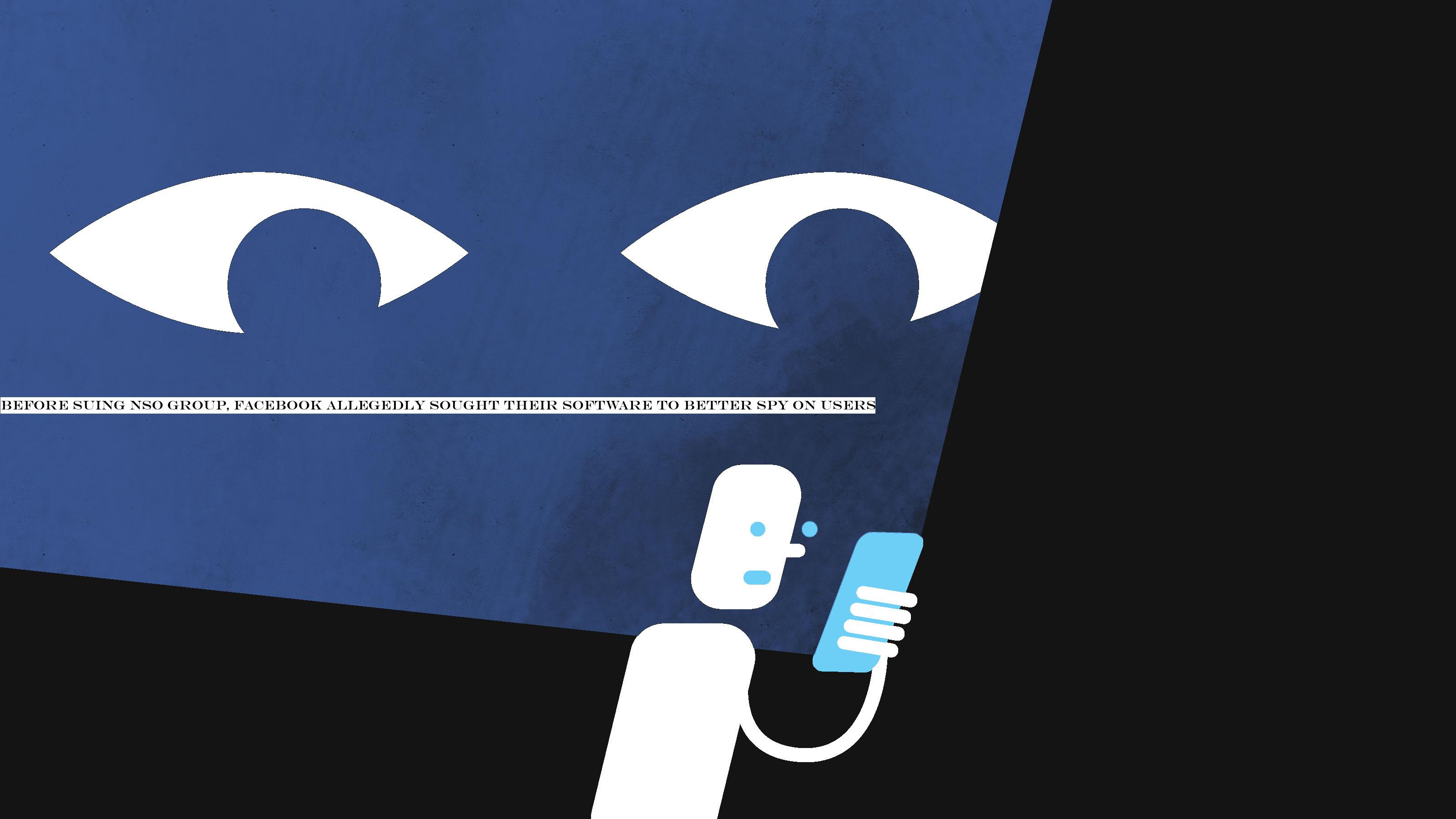
Facebook WhatsApp is in the midst of a lawsuit against Israeli mobile surveillance outfit NSO Group. But before complaining about the companymethods, Facebook seems to have wanted to use them for its own purposes, according to testimony from NSO founder Shalev Hulio.
Last year brought news of an exploit that could be used to install one of NSOspyware packages, Pegasus, on devices using WhatsApp. The latter sued the former over it, saying that over a hundred human rights activists, journalists and others were targeted using the method.
Last year also saw Facebook finally shut down Onavo, the VPN app it purchased in 2013 and developed into a backdoor method of collecting all manner of data about its users — but not as much as they&d have liked, according to Hulio. In a document filed with the court yesterday he states that Facebook in 2017 asked NSO Group for help collecting data on iOS devices resistant to the usual tricks:
In October 2017, NSO was approached by two Facebook representatives who asked to purchase the right to use certain capabilities of Pegasus, the same NSO software discussed in Plaintiffs& Complaint.
The Facebook representatives stated that Facebook was concerned that its method for gathering user data through Onavo Protect was less effective on Apple devices than on Android devices. The Facebook representatives also stated that Facebook wanted to use purported capabilities of Pegasus to monitor users on Apple devices and were willing to pay for the ability to monitor Onavo Protect users. Facebook proposed to pay NSO a monthly fee for each Onavo Protect user.
NSO declined, as it claims to only provide its software to governments for law enforcement purposes. But there is a certain irony to Facebook wanting to employ against its users the very software it would later decry being employed against its users. (WhatsApp maintains some independence from its parent company, but these events come well after the purchase by and organizational integration into Facebook.)
A Facebook representative did not dispute that representatives from the company approached NSO Group at the time, but said the testimony was an attempt to &distract from the facts& and contained &inaccurate representations about both their spyware and a discussion with people who work at Facebook.& We can presumably expect a fuller rebuttal in the companyown filings soon.
Facebook and WhatsApp are, quite correctly, concerned that effective, secret intrusion methods like those developed and sold by NSO Group are dangerous in the wrong hands — as demonstrated by the targeting of activists and journalists, and potentially even Jeff Bezos. But however reasonable Facebookconcerns are, the companystatus as the worldmost notorious collector and peddler of private information makes its righteous stance hard to take seriously.
- Details
- Category: Technology Today
Read more: Before suing NSO Group, Facebook allegedly sought their software to better spy on users
Write comment (99 Comments)Sick of sharing those generic Zoom video call invites that all look the same? Wish your Zoom link previewheadline and image actually described your meeting? Want to protect your Zoom calls from trolls by making attendees RSVP to get your link? ZmURL.com has you covered.
Launching today, ZmURL is a free tool that lets you customize your Zoom video call invite URL with a title, explanation and image that will show up when you share the link on Twitter, Facebook or elsewhere. ZmURL also lets you require that attendees RSVP by entering their email address so you can decide who to approve and provide with the actual entry link. That could stop Zoombombers from harassing your call with offensive screenshared imagery, profanity or worse.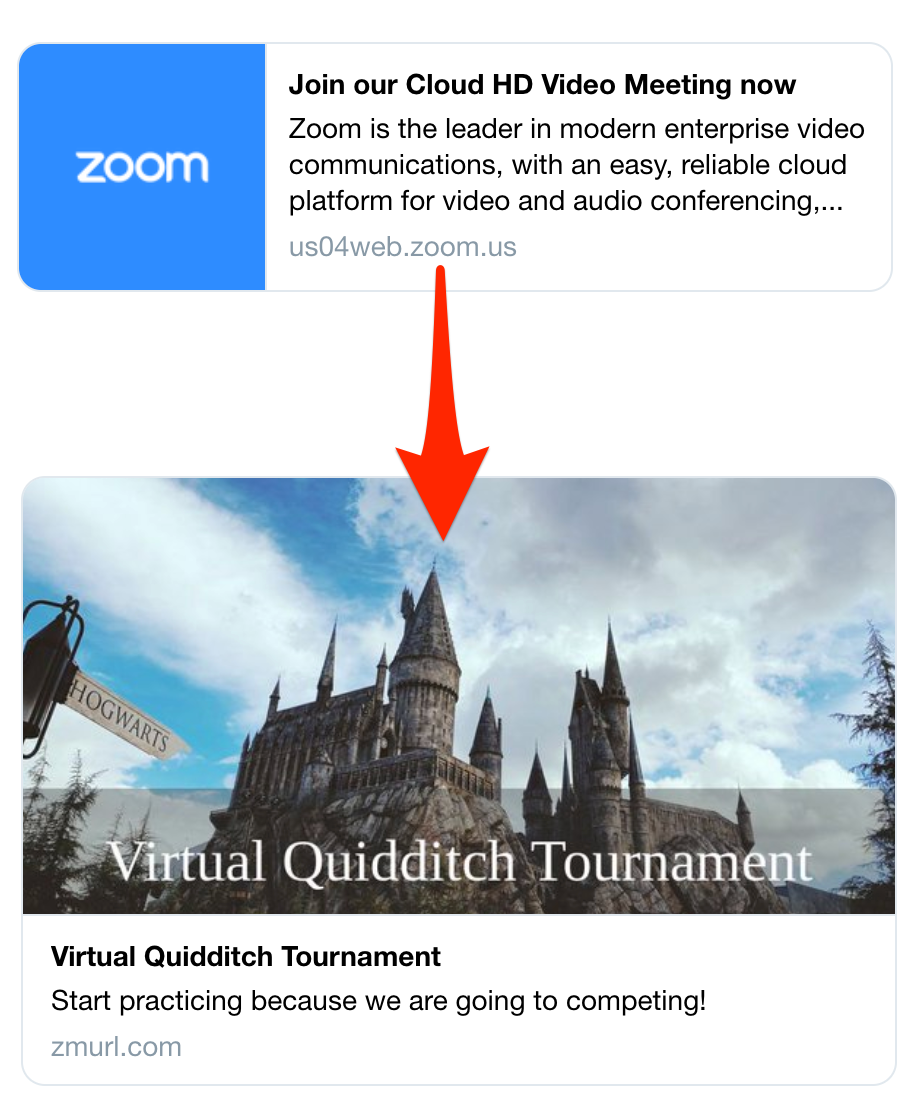
&We built zmurl.com to make it easier for people to stay physically distant but socially close,& co-founder Victor Pontis tells me. &We&re hoping to give event organizers the tools to preserve in-person communities while we are all under quarantine.&
Zoom wasn&t built for open public discussions. But with people trapped inside by coronavirus, its daily user count has spiked from 10 million to 200 million. Thatled to new use cases, from cocktail parties to roundtable discussions to AA meetings to school classes.
Thatunfortunately spawned new problems, like &Zoombombing,& a term I coined two weeks ago to describe malicious actors tracking down public Zoom calls and bombarding them with abuse. Since then, the FBI has issued a warning about Zoombombing, The New York Times has written multiple articles about the issue and ZoomCEO Eric Yuan has apologized.
Yet Zoom has been slow to adapt it features as it struggles not to buckle under its sudden scale. While it has turned on waiting rooms and host-only screensharing by default for usage in schools, most people are still vulnerable due to Zoompermissive settings and reused URLs that were designed for only trusted enterprise meetings. Only today did Zoom concede to shifting the balance further from convenience to safety, turning on waiting rooms by default and requiring passwords for entry by Meeting ID.
Meanwhile, social networks have become a sea of indistinguishable Zoom links that all show the same blue and white logo in the preview, with no information on what the call is about. That makes it a lot tougher to promote calls, which many musicians, fitness instructors and event producers are relying on to drive donations or payments while their work is disrupted by quarantines.

ZmURLfounders during their only in-person meeting ever
Luckily, Pontis and his co-founder Danqing Liu are here to help with ZmURL. The two software engineers fittingly met over Zoom a year ago and have only met once in person. Pontis, now in San Francisco, had started bike and scooter rental software companies Spring and Scooter Map. Liu, from Beijing but now holed up in New York, had spent five years at Google, Uber and PlanGrid before selling his machine learning tool TinyMind.
The idea for ZmURL stemmed from Liu missing multiple Zoom events he&d wanted to attend. Then a friend of Pontis& was laid off from their yoga instructor job, and they and their colleagues were scrambling to market and earn money from hosting their own classes over Zoom. The duo quickly built a beta, with zero money raised, and tested it with some yoga gurus who found it simplified promoting events and gathering RSVPs. &We&re all going through a tough time right now. We see ZmURL as our opportunity to help,& Pontis tells me.
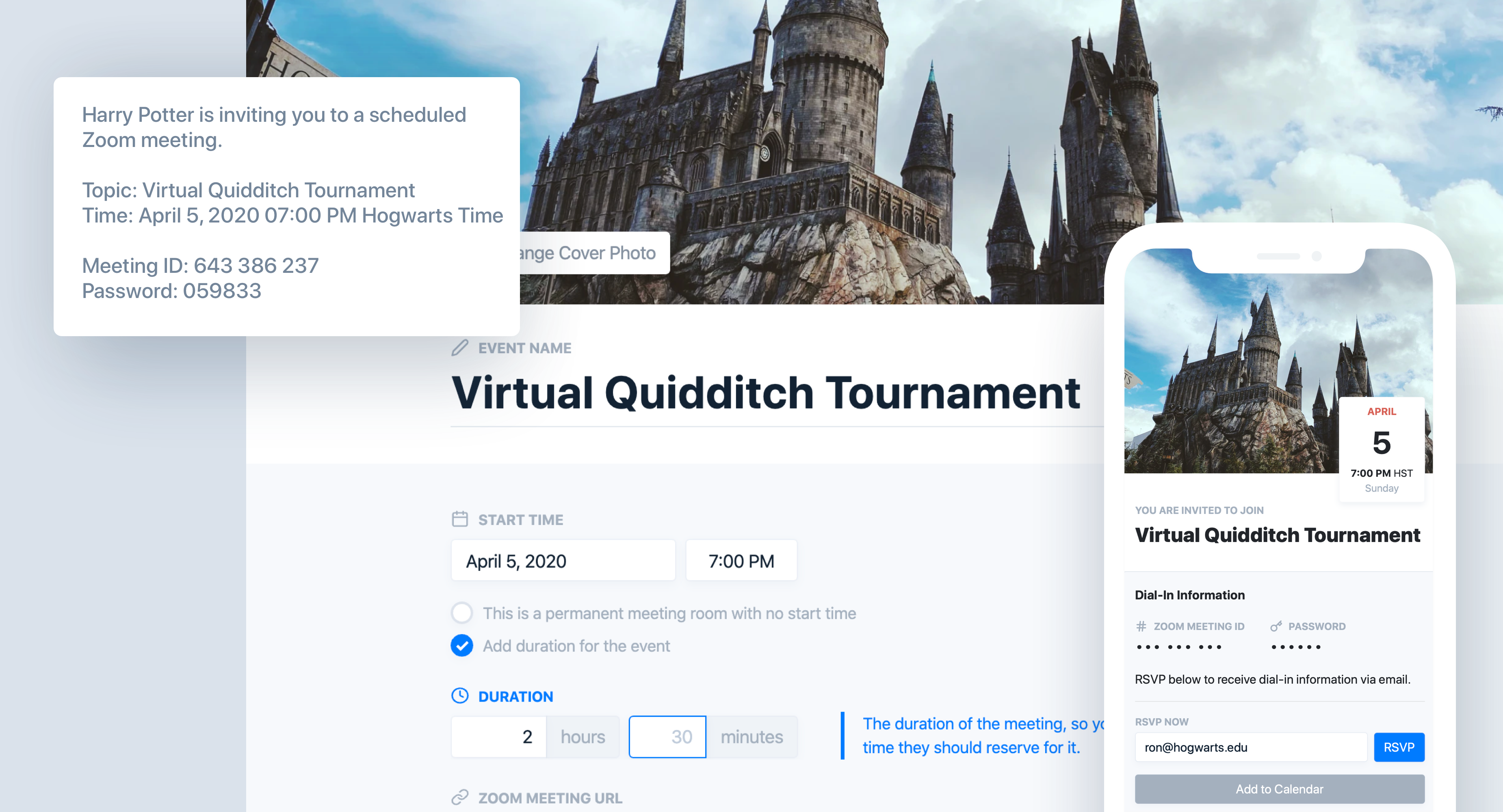
To use the tool, you generate a generic meeting link from Zoom like zoom.us/ji/1231231232 and then punch it into ZmURL. You can upload an image or choose from stock photos and color gradients. Then you name your event, give it a description and set the time and date. You&ll get a shorter URL like https://zmurl.com/smy5m or you can give it a custom one like zmurl.com/quidditch.
When you share that URL, it&ll show your image, headline and description in the link preview on chat apps, social networks and more. Attendees who click will be shown a nicely rendered event page with the link to enter the Zoom call and the option to add it to their calendar. You can try it out here, zmurl.com/aloha, as the startup is hosting a happy hour today at 6pm Pacific.
Optionally, you can set your ZmURL calls to require an RSVP. In that case, people who click your link have to submit their email address. The host can then sift through the RSVPs and choose who to email back the link to join the call. If you see an RSVP from someone you don&t recognize, just ignore it to keep Zoombombers from slipping inside.

Surprisingly, there doesn&t seem to be any other tools for customizing Zoom call links. Zoom paid enterprise customers can only set up a image and logo-equipped landing page for their whole companyZoom account, not for specific calls. For now, ZmURL is completely free. But the co-founders are building out an option for hosting paid events that collect entry fees on the RSVP site while ZmURL takes a 5% cut.
Next, ZmURL wants to add the ability to link your Zoom account to its site so you can spawn call links without leaving. Italso building out always-on call rooms, recurring events, organizer home pages for promoting all their calls, an option to add events to a public directory, email marketing tools and integrations with other video call platforms like Hangouts, Skype and FaceTime.
Pontis says the biggest challenge will be learning to translate more of the magic and business potential off offline events into the world of video calling. Therealso the risk that Zoom will try to intercede and force ZmURL to desist. But it shouldn&t, at least until Zoom builds all these features itself. Or it should just acquire ZmURL.
We&re dealing with an unprecedented behavior shift due to shelter-in-place orders that threaten to cripple the world economy and drive many of us crazy.Whether for fostering human connection or keeping event businesses afloat, Zoom has become a critical utility. It should accept all the help it can get.
- Details
- Category: Technology Today
Read more: ZmURL customizes Zoom link previews with images event sites
Write comment (97 Comments)Page 1044 of 1420

 12
12





